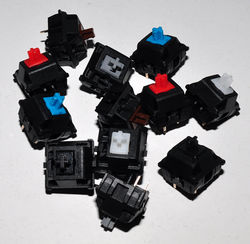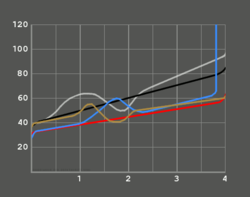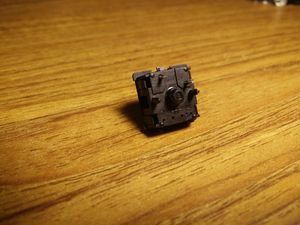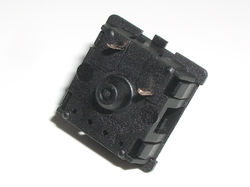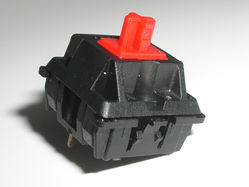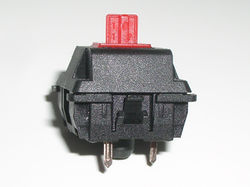Cherry MX
| This article requires additional photographic illustration — need photo of opened switch with diode (for this and the diode page) |
 | |
| Manufacturer | Cherry |
|---|---|
| Family | Cherry MX |
| Introduced | 1983-11-07 |
| Sense method | Metal contact |
| Rated lifetime |
20 M (1985) 500 k/20 M/50 M (1994) 50 M (2017) 50 M/100 M (2020) |
| Bounce time |
5 ms (1985) 1 ms (Nov 2019) |
| Keycap mount |
Cherry MX mount Hirose mount Cherry M8 mount |
| Switch mount |
PCB mount Plate mount |
| Patents | US4467160 (1983) |
| Website | https://www.cherry-world.com/cherry-mx |
Cherry MX is the most popular line of keyswitches used in mechanical computer keyboards.
Contents
History
Designed by Cherry, they were introduced on 7 November 1983[1] and were initially available only in a linear (smooth), light-resistance version.[Citation needed] An entire family of Cherry MX variants was subsequently developed with combinations of these characteristics:
- Light to heavy force
- With or without tactile feedback (a "bump" the typist can feel on actuation)
- With or without auditory feedback (clicky/non-clicky)
These variants are generally referred to by stem colour. Cherry officially refers to most switch types by article number, but their newest switch types are indeed referred to by community-style monikers on their website.
The exact history of the product line is not yet clear. In July 1985, the series officially comprised MX Black, MX Linear Grey (for space bars in MX Black keyboards), MX White, and MX Click Grey (for space bars in MX White keyboards). MX Lock appears to have already existed at this point (found in a Xerox keyboard made by Hirose Cherry), but it was not included in the 1985 German MX datasheet.
The part numbers were divided into linear and tactile, with the model character being numeric for linear switches (MX1A-11__ and MX1A-21__) and alphabetic for tactile switches (MX1A-A1__ and MX1A-B1__). MX Lock was identified as "3", but MX Red was strangely identified as "L" (with "H", "I", "J" and "K" currently unaccounted for), with the much later MX Nature White getting "4" following on from MX Lock.
The patent, filed in 1983, describes the hysteresis mechanism, but says nothing about audible feedback. It would appear that the click sound was originally suppressed with grease; MX Blue was a later addition to the series after MX Clear, and it was permitted to emit a click sound.
The 1985 MX datasheet lists a rated lifetime of 20 million keystrokes for both linear and tactile types. The 1994 MX brochure lists the lifetimes as 500 k (MX Lock), 20 M ("soft" and "click" types, where "soft" may refer to MX Clear), and 50 M for "linear" and "ergonomic" types (where "ergonomic" is MX Brown). From 2017, the whole series got rated for 50 M keystrokes, with MX Lock having gone end of life.
From November 1st, 2019 all variants are supposed to be manufactured with a different leaf spring and contacts, supposed to lead to a bounce time of less than 1 ms. In 2020, linear MX variants and MX Brown got modified stems (and possibly housing), with a new rating of 100 M keystrokes.[2]
The "MX2A" revision was announced in Aug 2023 for MX Black, Brown, Red, Blue, Speed Silver and Silent Red.[3] These have a new barrel-shaped spring with lubrication which supposedly "mirrors the performance of the Krytox GPL 205 Grade 0").[4] The label on the top housing of the RGB variants is now rotated 180°[5] whereas it is not on the non-RGB variants.[6] It is unclear whether or when the MX2A will replace the previous MX1A/MX3A switches.
Design
Cherry MX switches have gold crosspoint contacts. The contact mechanism has one small static terminal, and a movable leaf that is folded against itself at the top. At least two designs of contact mechanism are known. As of 2013, the current system has a very narrow "neck" where it folds back on itself. One known previous design uses more metal and appears to be more complicated; this design has been found in the Hirose Cherry MX Orange[7] and Hirose Cherry MX Clear, as well as Cherry MX Black.[8]
All German Cherry MX switches, and some Japanese-made Hirose MX switches, are branded "CHERRY" on the top; the exact logo used has varied over time. Hirose MX switches were also branded "HCP" (Hirose Cherry Precision).
The shell's design is based on the Cherry M9. The upper shell cannot be removed while the switch is mounted in a plate; it must first be de-soldered and removed, as the plate prevents the shell's four retention clips from moving outward. For modification, PCB-mount keyboards are preferred, or enthusiast-created plates with four small cutouts that allow the switches to be opened in-place.
Clicky MX switches use a special two-piece slider with a movable contact that fires the "click collar" downwards on passing the actuation point. When the switch is released, the click collar is pulled back upwards by the slider itself and held in place by the movable contact.
The keycap mount is only 180° rotationally symmetrical. The horizontal (E and W) arms of the cross are around 1.25–1.30 mm thick, while the vertical (N and S) arms are 1.05–1.10 mm thick. Keycaps do not always fit sideways. The stem is around 3.7 mm tall and sits on a platform that descends inside the switch, allowing the full travel to be greater than the stem's height.
Variants
Common variants
The most common Cherry MX variants are Black and Red for linear switches; and Clear, Brown and Blue for tactile switches. Keyboards based on the clicky MX Green and tactile MX Grey variants also exist; but due to their heavier resistance, these variants are usually reserved for space bars.
Hirose Cherry
Hirose Cherry Precision ("Cherry Japan") manufactured a version of the MX switch with the Hirose Cherry keycap mount. Hirose Cherry MX switches accept standard Cherry MX keycaps, but Hirose keycaps do not fit standard switches.
Other variants
Some rarer Cherry MX variants have transparent switch housings, and allegedly the earliest MX switches all had clear stems.[9]
Old versions of MX Blue switches exist. Because no dye was added to their stems, these switches are called Whites.[Citation needed]
Observed variants
| Name | Product code | Type | Key feel | Actuation | Mount | Stem cam | Production | |
|---|---|---|---|---|---|---|---|---|
 |
Cherry MX Black | MX1A-11xx | Normal | Linear | 60 cN | MX | No | Yes |
 |
Nixie | ? | Normal | Linear | 60 cN | MX | No | No |
 |
Nixie Spacebar | ? | Space Bar | Linear | ? | MX | No | No |
 |
Cherry MX Linear Clear | ? | Normal | Linear | ? | MX | No | No |
 |
Cherry MX Olympia Linear Clear | ? | Normal | Linear | ? | Revised MX | No | No |
 |
Cherry MX Linear Grey | MX1A-21xx | Space bar | Linear | 80 cN | MX | No | Yes |
 |
Cherry MX Lock | MX1A-31xx | Alternate action | Linear | 60 cN | MX | No | No |
 |
Cherry MX Black Clear-Top | MX1A-61NW | Normal | Linear | 63,5 cN | MX | No | Yes |
 |
Cherry MX White | MX1A-A1xx | Normal | Clicky | 80 cN | MX | Yes | Yes |
 |
Cherry MX Soft Click Clear | ? | Normal | Clicky | 50 cN | MX | No | No |
 |
Cherry MX Click Grey | MX1A-B1xx | Space bar | Clicky | 105 cN | MX | Yes | No |
 |
Cherry MX Clear | MX1A-C1xx | Normal | Tactile | 65 cN | MX | No | Yes |
 |
Cherry MX Tactile Grey | MX1A-D1xx | Space bar | Tactile | 80 cN | MX | No | Yes |
 |
Cherry MX Blue | MX1A-E1xx | Normal | Clicky | 60 cN | MX | Yes | Yes |
 |
Cherry MX Green | MX1A-F1xx | Space bar | Clicky | 80 cN | MX | Yes | Yes |
 |
Cherry MX Brown | MX1A-G1xx | Normal | Tactile | 55 cN | MX | No | Yes |
 |
Cherry MX Ergo Clear | MX1A-H1xx | Normal | Tactile | 55 cN | MX | No | Yes |
 |
Cherry MX Red | MX1A-L1xx | Normal | Linear | 45 cN | MX | No | Yes |
 |
Cherry MX Silent Red | MX3A-L1xx | Normal | Linear | 45 cN | MX | No | Yes |
 |
Cherry MX Silent Black | MX3A-11xx | Normal | Linear | 60 cN | MX | No | Yes |
 |
Cherry MX RGB Black | MX1A-11xx | Normal | Linear | 60 cN | MX | No | Yes |
 |
Cherry MX RGB Blue | MX1A-E1xx | Normal | Clicky | 60 cN | MX | Yes | Yes |
 |
Cherry MX RGB Brown | MX1A-G1xx | Normal | Tactile | 55 cN | MX | No | Yes |
 |
Cherry MX RGB Red | MX1A-L1xx | Normal | Linear | 45 cN | MX | No | Yes |
 |
Cherry MX Silent RGB Red | MX3A-L1xx | Normal | Linear | 45 cN | MX | No | Yes |
 |
Cherry MX Silent RGB Black | MX3A-11xx | Normal | Linear | 60 cN | MX | No | Yes |
 |
Cherry MX Speed Silver | MX1A-51xx | Normal | Linear | 45 cN | MX | No | Yes |
 |
Cherry MX Speed RGB Silver | MX1A-51xx | Normal | Linear | 45 cN | MX | No | Yes |
 |
Cherry MX RGB Nature White | MX1A-41NA | Normal | Linear | 55 cN | MX | No | Yes |
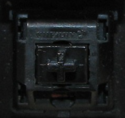 |
Cherry MX Super Black | ? | Special | Linear | 150 cN | MX | No | No |
 |
Cherry MX-M8 Adapter | ? | Normal | Linear | ? | M8 | ? | No |
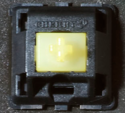 |
Hirose Cherry MX Pale Yellow | ? | Normal | Linear | ? | Hirose | No | No |
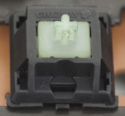 |
Hirose Cherry MX Grey Green | ? | Normal | Linear | ? | Hirose | No | No |
 |
Hirose Cherry MX Orange | ? | Normal | Linear | ? | Hirose | No | No |
 |
Cherry MX Pale Blue | ? | Normal | Clicky | ? | MX | Yes | No |
 |
Cherry MX Dark Blue | ? | Normal | Clicky | 50 cN | MX | Yes | No |
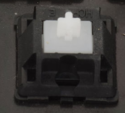 |
Hirose Cherry MX Clear | ? | Normal | Linear | ? | Hirose | No | No |
MX2A revision
| Name | Product code | Key feel | Actuation |
|---|---|---|---|
| Cherry MX2A Black | MX2A-11Nx | Linear | 60 cN |
| Cherry MX2A Speed Silver | MX2A-51Nx | Linear | 45 cN |
| Cherry MX2A Silent Red | MX2A-71Nx | Linear | 45 cN |
| Cherry MX2A Brown | MX2A-G1Nx | Tactile | 55 cN |
| Cherry MX2A Red | MX2A-L1Nx | Linear | 45 cN |
| Cherry MX Purple | Tactile | <50 cN | |
| Cherry MX Silent Clear | MX2A-J1NB | Tactile | 60 cN |
| Cherry MX Orange | MX2A-LC3W | Linear | 55 cN |
The last letter in the product code:
- N: 3-pin
- W: 5-pin
- A: 3-pin RGB
- B: 5-pin RGB
Country-specific types
Position six in product codes is "1" for a Cherry MX keystem, and a country-specific letter otherwise. The only known example of this is "G" for Germany; these switches are listed by a number of stockists and other sites, but in all cases appear to be false stock levels and no parts are available for sale. Cherry Americas have three of the products on record, as obsolete parts (two of which with meaningful descriptions), and examples of three of the types in their offices (MX1A-1GBR, MX1A-EGEQ and MX1A-1GCL); the remainder of the product codes below remain entirely unconfirmed. The three examples where parts have been retained are all Cherry MX mount, and the only apparent difference in all cases is customisation of the return spring weight.[10]
| Product code | Source | Description |
|---|---|---|
| MX1A-1GAP | Cherry | "MX1A-1GAP" [sic] (database record only) |
| MX1A-1GBR | Cherry | Derived from MX Black, PCB mount, 179 cN according to the database record ("179 CN PCB MOUNT N/O") |
| MX1A-1GCX | Cherry | "350CN W/PINS" (database record only) |
| MX1A-1GCL | Cherry | Derived from MX Black; PCB mount; the bag states “lowest force possible”, but it seems to be only slightly lower in force than standard MX Black; the bag is dated 8-26-94 |
| MX1A-EGEQ | Cherry | Derived from MX Blue; PCB mount, 180 cN |
| MX1A-1GER | Surplus sites | None |
| MX1A-1GFD | Surplus sites | None |
| MX1A-1GRE | Surplus sites | None |
Unconfirmed variants
"Cherry MX Yellow" (Aristotle Yellow) is now officially determined to not be a Cherry product. As such, the following switches—not yet sighted in any keyboard at the time of writing—are not verified Cherry products. They are Cherry-branded, but they may be counterfeit.
| Name | Product code | Type | Key feel | Actuation | Mount | Stem cam | Production | |
|---|---|---|---|---|---|---|---|---|
 |
Cherry MX Alps Click | ? | ? | Clicky | ? | Alps | N/A | No |
 |
Cherry MX Alps Linear | ? | ? | Linear | ? | Alps | N/A | No |
 |
Cherry MX Pale Grey | ? | ? | Linear | ? | MX | ? | No |
Recombination variants
There are several custom Cherry MX switches that can be created by merging together two different switches.
- Cherry MX Ghetto Green
- Cherry MX Panda Clear
- Cherry MX Ergo Clear
- Cherry MX Ergo Grey
- Cherry MX Ghost Black
- Cherry MX Light White
Features (as advertised by Cherry)
- Desktop profile, 0.60 inch (15.2 mm) from PCB (no keycap)
- Choice of feel: linear, soft tactile, click tactile
- PCB or frame mount
- Long life of 50 million operations (previously also 20 million and 500 thousand depending on model and age)
- 4 mm travel
- LED, diode or jumper option
- 12V maximum AC/DC
- Current Rating: 10 mA
- Insulation Resistance: < 100 MΩ at 100V DC
Mounting options
Cherry MX switches are available with additional mounting options for either a wire bridge, an LED or a diode.
They are also available for either PCB or plate mounting. Switches for PCB mounting have two additional plastic pins to secure and stabilize them (although plate-mounted switches do not necessarily need these extra pins, as they are stabilized by the metal backplate). PCB-mounted switches can easily be converted for back-plate mounting by cutting off the extra stems.
Mounting designs are specified by the last two digits of the switches' product numbers (see below).
Product numbers
The Cherry MX series follows an eight-digit naming convention: M X [1,3,5] [A,C] - [0-9, A-Z] [1] [N,R,G,Y,D,J] [N,W,A,B]
- M: Keyswitch module
- X: Cherry MX family
- [1,3,5]
- 1: Material: AuAg10, 10mA, max. 12V
- 3: Silenced slider
- 5: Special
- [A,C]
- A: SPST NO (single pole, single throw, normally open)
- C: Special
- [0-9, A-Z] — Operating characteristics, actuation force and key style (switch 'color'):
- [1,A-Z]
- 1: Standard straight, cross-shaped keystem for standard Cherry MX mount caps
- G: Special (Germany) with D and H reserved for future use
- W: Special (USA) with C and F reserved for future use (yet to be observed)
- U: Special (UK) with K and E reserved for future use (yet to be observed)
- N: Special (Japan) with J and L reserved for future use (yet to be observed)
- A: Special (Australia) with Q and M reserved for future use (yet to be observed)
- B: Special (Brazil) with S and P reserved for future use (yet to be observed)
- [N,R,G,Y,D,J] - Integrated components
- N: No additional, integrated components
- R: Red LED
- G: Green LED
- Y: Yellow LED
- D: Diode
- J: Jumper wire
- [N,W] - Mounting configuration / case color
- N: No plastic mounting pins (plate mount) / black case
- W: With plastic mounting pins (PCB mount) / black case
- A: No plastic mounting pins (plate mount) / clear case
- B: With plastic mounting pins (PCB mount) / clear case
Examples of Cherry MX product numbers and their descriptions:
- MX1A-11NN - Cherry MX Black/linear, no diode, plate mount (no fixing pins)
- MX1A-E1DN - Cherry MX Blue/tactile clicky, with diode, plate mount (no fixing pins)
- MX1A-L1RW - Cherry MX Red/low-force linear, red LED, PCB mount (with fixing pins)
- MX1A-G1JW - Cherry MX Brown/tactile non-clicky, with jumper wire, PCB mount (with fixing pins)
Disassembly
The Cherry MX switch shell is based on Cherry's previous low-profile M9 switch ("low-profile" in the '80s being standard profile from the '90s onward).
The switch has four retention tabs: two on the left and two on the right. A loose switch can be opened by prying these tabs either from the top or from the bottom. Enthusiasts have developed special tools for both methods, but narrow flat screwdrivers are also often used. The screwdrivers are inserted into two opposite holes; then the side retention tabs are pried away from the switch body.
PCB-mounted MX switches can be opened in-place from the top. Most plate-mounted switches must be removed to be opened, as the plate prevents their side tabs from moving outward to clear the retaining lugs. Some DIY keyboard kits have cutouts for the retention tabs, allowing them to be opened in place. Other keyboards, primarily for enthusiasts, have hot-swapping sockets allowing switches to be removed and replaced without de/soldering.
Gallery
Accessories
Design
Variant design used for windowed keycaps on certain Cherry models such as the G80-3700HAU/04
Construction
Silencing
To provide damping, Cherry revised the slider to contain an integral, fully moulded-in-place damper. The damped switches use softer colours for the sliders.
See also
References
- ↑ Deskthority — 7 November 1983-2013 | 30 Years Cherry MX! Posted 2013-11-06. Retrieved 2024-05-17.
- ↑ Cherry MX blog — CHERRY MX UPDATE: More than 100 million actuations and a bounce time of less than one millisecond by Holger Dassler. Posted 2020-03-23. Retrieved 2024-05-17
- ↑ Cherry MX blog — CHERRY MX2A: Exceeding expectations - The ultimate in mechanical switch design Attributed to Holger Dassler. Dated 2023-08-24. Retrieved 2024-05-17.
- ↑ Cherry Corp. — The original Cherry MX switches No dating. Retrieved 2024-05-17.
- ↑ Theremingoat.com — Cherry MX2A RGB Black Switch Review Dated 2023-08-27. Retrieved 2024-05-17.
- ↑ Ars Technica — Hands-on with Cherry MX2A switches: A lot less wobble, a little more confusion by Scharon Harding. Dated 2023-08-26. Retrieved 2024-05-17.
- ↑ ちゃたりたいね — YAMAHA QX3 シーケンサ Cherry オレンジ軸 (Japanese) (Wayback Machine) Posted 2013-06-17. Archived 2014-07-27.
- ↑ Geekhack — This cherry switch (Note: Pictures are gone!) Posted 2013-10-29. Retrieved 2024-05-17.
- ↑ Deskthority — Hirose Cherry switches and the Xerox 1109 Posted 2014-06-07. Retrieved 2024-05-17.
- ↑ Correspondence with Cherry Americas, 2017-10-02 to 10
External links
- Kaihua — 红轴将被取代 Kailh黄轴大战Cherry轴 — Detailed disassembly shots (Wayback Machine) Archived 2014-08-28.
